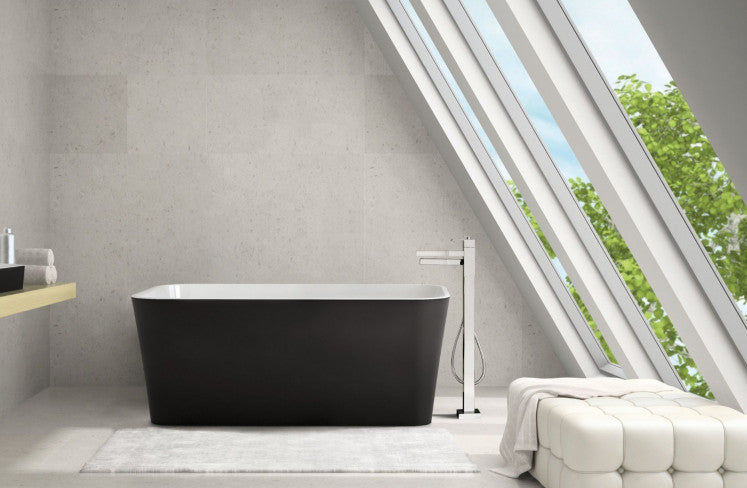

Laundry Sinks: Choosing the Right Style and Size for Your Space
by Kirill Kutsak , 10 min reading time
When upgrading or designing a laundry room, laundry sinks are often overlooked despite being essential to a functional and efficient space. Also known as utility sinks or laundry room sinks, these versatile fixtures add convenience for tasks like hand-washing delicate items, cleaning up messes, or tackling any dirty work you wouldn’t want in your kitchen sink. With numerous styles, materials, and sizes available, choosing the right laundry sink can enhance the functionality of your space and make everyday chores easier. This guide covers everything you need to know to select the ideal laundry sink for your home.
Table of Contents
- Why You Need a Laundry Sink
- Types of Laundry Sinks
- Choosing the Right Size for Your Laundry Sink
- Material Options for Laundry Sinks
- Accessories to Enhance Your Laundry Sink’s Functionality
- Installation Tips and Considerations
- Innovative Features in Modern Laundry Sinks
- Maintenance and Care for Longevity
- Conclusion
Why You Need a Laundry Sink
A laundry sink can make daily chores more manageable. Whether you're rinsing paintbrushes, soaking soiled clothes, or simply washing hands after a day in the garden, laundry sinks are designed to handle tough jobs that other household sinks aren't equipped for. Here’s why you might want to invest in one:
- Versatile Utility: Laundry sinks are ideal for messy, utility-focused tasks that are better suited to a dedicated space.
- Protects Other Surfaces: By using a laundry sink for messy jobs, you prevent staining or clogging your bathroom or kitchen sinks.
- Enhanced Functionality: Laundry sinks often come with deep bowls and durable materials, designed to accommodate larger items and tougher cleaning.
Whether you're outfitting a small apartment or a spacious home, choosing the right sink for your laundry room involves considering style, size, and material to ensure the sink complements the overall design of your space.
Zitta Acrylic Laundry Sinks 25" x 21 ½" x 15 ½"
Types of Laundry Sinks
When choosing a laundry sink, you'll find that there are various types to suit different needs and aesthetics. Here’s a look at the most common options:
Freestanding Laundry Sinks
Overview: Freestanding laundry sinks are standalone fixtures that don’t require cabinets or counters. These are typically supported by sturdy metal or plastic legs and are easy to install.
Benefits: They are highly functional, offering large basin sizes and easy installation. They also often have lower costs since they don't require cabinetry.
Ideal For: Basements, garages, or laundry rooms where space and aesthetics are not a primary concern.
Drop-In Laundry Sinks
Overview: Drop-in sinks are installed into a countertop, creating a seamless look in a more built-out laundry room. They are partially inserted, with a rim resting on top of the counter.
Benefits: These sinks are both functional and stylish, providing a clean look while saving counter space around the sink.
Ideal For: Homeowners who want a polished, built-in look for their laundry room.
Undermount Laundry Sinks
Overview: Undermount sinks are installed beneath the countertop, providing a seamless look without a raised rim.
Benefits: These sinks are easy to clean, as water and debris can be wiped straight into the sink from the counter. They’re sleek, modern, and allow for maximum countertop space.
Ideal For: Modern laundry rooms where style and functionality are prioritized.
Wall-Mounted Laundry Sinks
Overview: Wall-mounted sinks are directly attached to the wall, without the need for countertop support.
Benefits: These sinks save floor space, making them perfect for smaller laundry rooms.
Ideal For: Smaller laundry rooms, or spaces where additional floor space is necessary.
Utility Tubs with Storage Cabinets
Overview: Utility sinks integrated into cabinets or storage units provide both a sink and additional storage space.
Benefits: This option is highly functional and aesthetically pleasing, providing both washing space and storage for cleaning supplies.
Ideal For: Those who need additional storage space and want a sleek, contained look in their laundry room.
Choosing the Right Size for Your Laundry Sink
Size matters when selecting a laundry sink. A sink that’s too small might not handle larger tasks, while one that’s too big may overwhelm the room. Here are some factors to consider when choosing the right size:
Space Available
- Measure your laundry room and determine where the sink will go.
- Make sure to account for any surrounding doors, cabinets, or appliances that could obstruct access.
Depth of the Sink
Laundry sinks are typically deeper than standard kitchen sinks, ranging from 10 to 25 inches.
- Shallow Sinks (10–12 inches): Ideal for light-duty tasks.
- Medium Depth (13–18 inches): Good for general laundry and cleaning tasks.
- Deep Sinks (20–25 inches): Perfect for large, heavy-duty cleaning jobs.
Width and Length
Laundry sinks come in a variety of widths and lengths. Choose one that balances with your space without overwhelming the area.
- Consider that larger, wider sinks (24–36 inches) will be more useful for tasks like washing pets, while smaller sinks (15–18 inches) are suitable for light-duty tasks in smaller spaces.
Material Options for Laundry Sinks
Laundry sinks are available in a range of materials, each offering different benefits in terms of durability, aesthetics, and maintenance. Here are some popular materials to consider:
Stainless Steel
- Pros: Durable, stain-resistant, and easy to clean. Stainless steel is perfect for high-usage laundry rooms and provides a professional, industrial look.
- Cons: It can be noisy, but using a sink liner or adding sound-dampening materials can help.
- Best For: Heavy-duty, functional spaces like basements and garages.
Acrylic
- Pros: Lightweight, budget-friendly, and resistant to scratches and stains.
- Cons: Less heat-resistant than other materials, and can be prone to cracking over time.
- Best For: Family homes or low-use laundry rooms, where affordability is a priority.
Cast Iron with Enamel Finish
- Pros: Extremely durable with a classic, polished look. The enamel coating is highly resistant to stains and scratches.
- Cons: Heavy and requires additional support for installation.
- Best For: Stylish laundry rooms with a vintage aesthetic.
Ceramic
- Pros: Aesthetic appeal, easy to clean, and resistant to scratches and stains.
- Cons: More delicate and prone to chipping than other materials.
- Best For: Light-use laundry rooms with a focus on aesthetics.
Accessories to Enhance Your Laundry Sink’s Functionality
Adding accessories to your laundry sink can make it even more versatile. Consider these enhancements:
- Pull-Down or Sprayer Faucet: Ideal for directing water exactly where you need it.
- Drying Rack or Basin Grid: Allows for air-drying items and protects the sink surface from scratches.
- Utility Carts or Cabinets: Provide additional storage for cleaning supplies, laundry detergents, and other necessities.
- Built-In Soap Dispensers: Keep the area tidy and reduce clutter around the sink.
Installation Tips and Considerations
Installing a laundry sink is generally manageable, but planning is key to a smooth installation process. Here are some factors to consider:
- Plumbing Access: Ensure that there is a water supply line and drain system nearby to simplify the installation.
- Placement: Position the sink in a convenient location in your laundry room, preferably near the washing machine.
- Floor Support: For heavy sinks like cast iron, make sure your floor is capable of supporting the weight.
- Professional Installation: If you’re not confident in handling the installation, consider hiring a professional plumber.
Innovative Features in Modern Laundry Sinks
Modern laundry sinks have evolved beyond basic functionality, incorporating innovative features that enhance convenience and efficiency. When selecting a laundry sink, consider these advanced options:
- Integrated Washboards: Some sinks come with built-in washboards, allowing for easy scrubbing of stains directly in the sink. For instance, the Ruvati Alto collection features a unique wooden washboard that sits at an angle, facilitating handwashing of clothes directly in the sink.
- Workstation Designs: Certain models transform into multifunctional workspaces with accessories like cutting boards, drying racks, and colanders. These additions maximize utility, especially in compact laundry rooms. The Kraus Standart PRO utility sink, for example, includes a protective stainless steel bottom grid and a premium drain assembly with a decorative drain cap, enhancing its functionality.
- Noise Reduction Technology: To minimize noise during use, some stainless steel sinks incorporate soundproofing features. The Kraus KHU24L model utilizes NoiseDefend Soundproofing Technology, featuring extra-thick pads covering over 80% of the sink and non-toxic undercoating for added insulation.
- Advanced Drainage Systems: Modern sinks often include engineered drain grooves that direct water toward the drain, preventing standing water and facilitating quicker drying. The Kraus KHU24L model, for instance, features engineered drain grooves that direct water toward the drain to keep the sink free of standing water.
Maintenance and Care for Longevity
Proper maintenance of your laundry sink ensures its durability and continued aesthetic appeal. Here are some care tips based on the sink material:
- Stainless Steel Sinks: Regular cleaning with mild dish soap and water prevents buildup. To restore shine, use a mixture of baking soda and water to gently scrub the surface, followed by rinsing and drying. Avoid abrasive cleaners that can scratch the finish.
- SILGRANIT Sinks: For daily cleaning, use a sponge with mild dish soap or baking soda and water. For deeper cleaning, BLANCO recommends using a mild liquid or gel laundry detergent. Close the sink drain, distribute the detergent evenly onto the sink surface, fill the sink with hot water (up to 60°C / 140°F), and let it sit for at least 2 hours or ideally overnight.
- Acrylic Sinks: Clean with a non-abrasive cleaner and a soft cloth to prevent scratches. Avoid placing hot pots or pans in the sink, as acrylic is sensitive to heat.
- Cast Iron Sinks: Use a gentle cleanser and soft sponge to maintain the enamel finish. Promptly clean any stains to prevent permanent discoloration.
Regular maintenance not only preserves the appearance of your laundry sink but also extends its lifespan, ensuring it remains a functional and attractive feature in your home.
Conclusion
A laundry sink is an essential addition to any laundry room, providing functionality and convenience for a variety of tasks. Whether you're looking for a compact, wall-mounted option for a small laundry room or a deep utility tub for a garage workshop, there’s a style, size, and material to meet your needs. With the right sink, you can make laundry tasks more efficient and protect the surfaces and appliances throughout the rest of your home.
When selecting the perfect laundry sink, take time to consider the space, functionality, and materials that will serve you best.
Explore our laundry sink collection to find a variety of styles and materials to suit your needs.
Blog posts
-

, by Ronaldo Grimshaw Craftsmanship Redefined: House of Rohl's Finest Plumbing Fixtures
-

, by Ronaldo Grimshaw Discover House of Rohl's Luxurious Bathroom Collections
-

, by Ronaldo Grimshaw House of Rohl Welcomes New Brands



